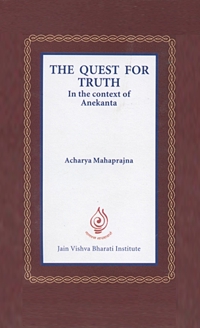
A storm was raging. One cannot say that tomorrow's storm will have the same force as todays. What was yesterday is not necessarily what is today or what will be tomorrow. In this world there is no space for sameness. That which exists has many forms. The hair that is white today must have been black some day. The hair that is black today will become white one day. They do not always remain the same. This is not true only for the hair. Nothing in this world can ever remain the same. Jain philosophy has explored, in depth, the reason for these multi-dimensional forms or in other words the lack of sameness. It has viewed it through intuitive perception.
After reflection and perception a principle has been established. That principle is called Changing Permanence (parinanityitavat). According to this principle no substance in this world is forever permanent or impermanent. Every substance has an intrinsic harmony between the permanent and the impermanent. The existence of reality is eternal and so it is permanent. That which is eternal is not without transformation. And the transformation is not without the eternal. That is why it is impermanent also. It emerges in one form and after a certain time period changes into another form. It is therefore evident that every substance is the integration of three characteristics, namely origination, destruction and the eternal. Origination and destruction become the cause for the transformation arid permanence is their underlying concomitance. Permanence is there in its state of origination as well as in its state of destruction. It is linked to both origination and destruction. That form which is coming into being is not coming into being for the first time. Similarly that which is being destroyed is not being destroyed for the first time.
This process of origination and destruction has taken place many times over. Reality has not been created on its origination neither has it been destroyed on its destruction. Permanence gives origination and destruction a certain order but does not let any fundamental change take place in reality or existence. The fundamental form of reality or existence does not change. Those who rest their philosophy on this point propound the philosophy of absolute permanence. Those who cling only to the waves of the ocean of reality propound the fluxist philosophy. Jain philosophy has seen both these aspects in one single strain of thought and so it has established the principle of changing permanence.
Bhagwan Mahaveer has explained every reality in terms of changing permanence. He was asked - is the soul permanent or impermanent? Is matter permanent or impermanent? He gave only one answer - reality never ends. From this perspective, it is permanent. The process of change is never violated and from this perspective it is impermanent. In the language of totality there is neither the impermanent nor the permanent everything is permanent cum impermanent.
There are two attributes to reality
- sahabhavi or that which persists and
- kramabhavi or that which changes successively.
The sahabhavi indicates the state of reality while the kramabhavi indicates its pace. The sahabhavi is called its trait or gun while the kramabhavi is called the mode (paryay).
The famous aphorism of Jain philosophy is that no mode can exist without substance and no substance can exists without mode.
One Jain philosopher asked the philosophers believing in absolute permanence, the Vedantins, "Who has seen substance without modes? Have they seen it? When have they seen it? In what form have they seen it? Let us know. In the same manner he asked the fluxists who has seen change without substance. Where have they seen it? When have they seen it? In what form have they seen it? The sequence of change has a certain permanent principle behind it. The events of changes take place in it and not outside it. If you throw a pebble into a lake there are ripples. The form of the lake changes. The water, which was peaceful, has now become disturbed. The small ripples are in water. Without water these ripples do not have any existence; because there are ripples in water we can say that the lake is disturbed. The creation of ripples is an event. It takes place under certain conditions. If there were no lake, there would be no water. If there were no water there would be no ripple. The existence of ripples is dependent on the existence of water. It can also not be possible that there is water but there are no ripples. The existence of water is closely linked to the existence of ripples. Both are imbued with each other - water in ripples and ripples in water.
 Acharya Mahaprajna
Acharya Mahaprajna


